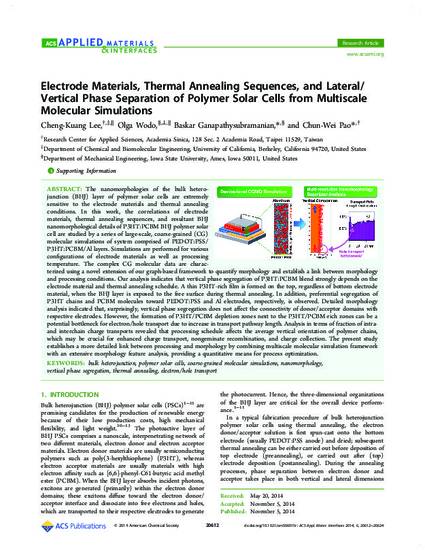
The nanomorphologies of the bulk heterojunction (BHJ) layer of polymer solar cells are extremely sensitive to the electrode materials and thermal annealing conditions. In this work, the correlations of electrode materials, thermal annealing sequences, and resultant BHJ nanomorphological details of P3HT:PCBM BHJ polymer solar cell are studied by a series of large-scale, coarse-grained (CG) molecular simulations of system comprised of PEDOT:PSS/P3HT:PCBM/Al layers. Simulations are performed for various configurations of electrode materials as well as processing temperature. The complex CG molecular data are characterized using a novel extension of our graph-based framework to quantify morphology and establish a link between morphology and processing conditions. Our analysis indicates that vertical phase segregation of P3HT:PCBM blend strongly depends on the electrode material and thermal annealing schedule. A thin P3HT-rich film is formed on the top, regardless of bottom electrode material, when the BHJ layer is exposed to the free surface during thermal annealing. In addition, preferential segregation of P3HT chains and PCBM molecules toward PEDOT:PSS and Al electrodes, respectively, is observed. Detailed morphology analysis indicated that, surprisingly, vertical phase segregation does not affect the connectivity of donor/acceptor domains with respective electrodes. However, the formation of P3HT/PCBM depletion zones next to the P3HT/PCBM-rich zones can be a potential bottleneck for electron/hole transport due to increase in transport pathway length. Analysis in terms of fraction of intra- and interchain charge transports revealed that processing schedule affects the average vertical orientation of polymer chains, which may be crucial for enhanced charge transport, nongeminate recombination, and charge collection. The present study establishes a more detailed link between processing and morphology by combining multiscale molecular simulation framework with an extensive morphology feature analysis, providing a quantitative means for process optimization.
Available at: http://works.bepress.com/baskar-ganapathysubramanian/32/

This is an article published as Lee, Cheng-Kuang, Olga Wodo, Baskar Ganapathysubramanian, and Chun-Wei Pao. "Electrode materials, thermal annealing sequences, and lateral/vertical phase separation of polymer solar cells from multiscale molecular simulations." ACS applied materials & interfaces 6, no. 23 (2014): 20612-20624. DOI:10.1021/am506015r. Posted with permission.